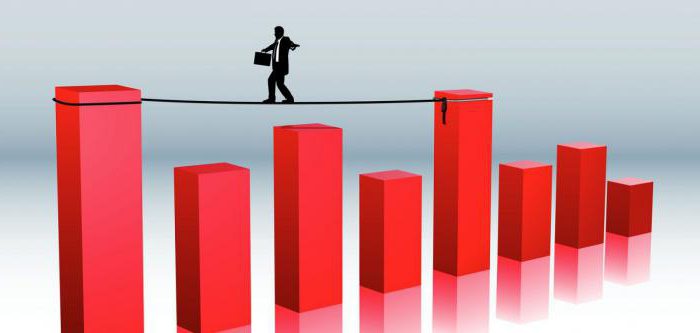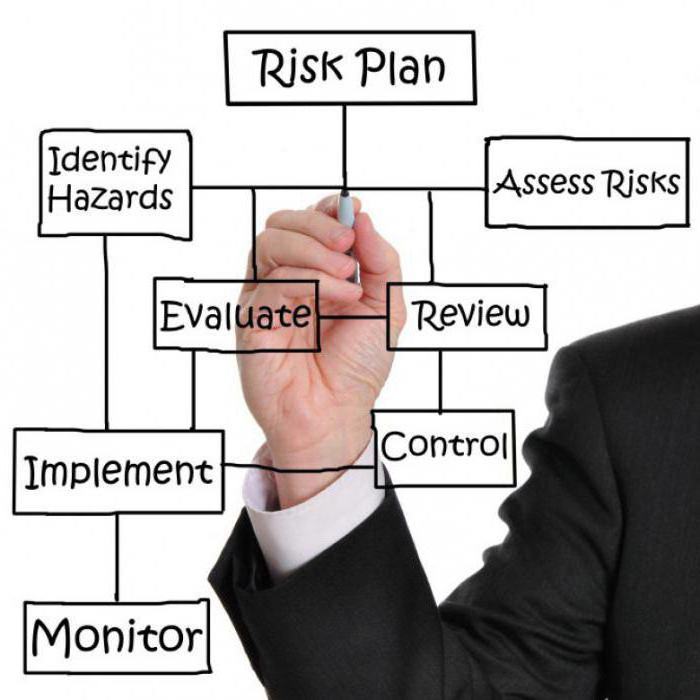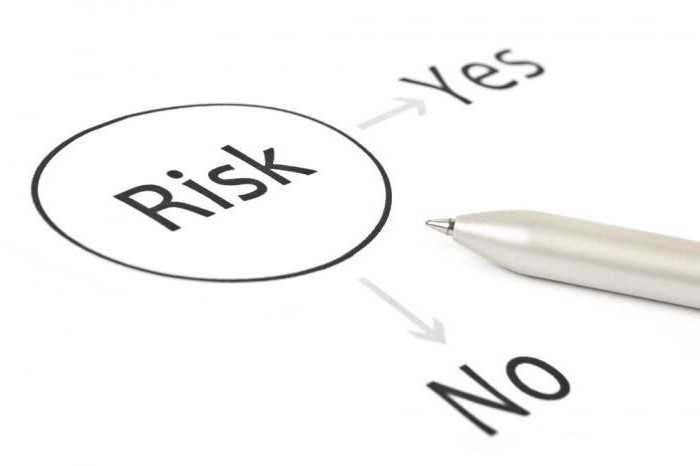Entrepreneurship is always in danger. Any action of a businessman can turn into a risk and lead to damage, losses and losses. A powerful incentive that forces a person to commit them is the probability of a certain income.
Risk identification
Modern business practice not so long ago acquired such concepts as “risk profile”, “unstable situation”, “risk analysis”, “risk minimization”. Only a few years ago, the combination of accumulated international experience and the Russian theoretical base made it possible to legislate these concepts, as well as make them an indispensable part of a business plan or investment project. 
Risk is the likelihood of how much the estimated income will be lost or how much of the resources will be lost.
Risk characterization:
- potential damage expressed in money;
- probability of occurrence of risk;
- the level of risk, that is, the ratio of the costs required to prepare and implement the risk and potential damage: if the result exceeds 1, then the risk is considered unjustified;
- legitimacy of risk: this value is determined by the probability of finding the risk within the limits established by law and standards (for example, the reserve fund of a tour operator should be no less than 1 million rubles).
Human activity also always accompanies risk. The cause of danger may be the environment or the person himself.
Risk is the likelihood that a danger will occur, causing specific consequences and an indefinite amount of damage. An example is the risk of disease.
Entrepreneurial Risks
Entrepreneurial risk was first classified by J. Keynes. He believed that the composition of the price of goods should include: costs associated with increased wear and tear on the equipment used, market volatility, as well as a number of damage caused by any emergency (costs of risk).
In the economic sphere, it is customary to single out the following types of entrepreneurial risks:
- Risk of the borrower or entrepreneur - arises if it is planned to invest its own funds, and the entrepreneur has doubts as to whether the benefit that he planned would be achieved.
- Lender risk - occurs in cases where a credit operation takes place. It is associated with the validity of the trust, because the debtor may begin to evade fulfillment of his own obligation or organize intentional bankruptcy. The likelihood of risk also increases due to insufficient loan security in the event that involuntary bankruptcy occurs as a result of the fact that the estimated income is not achieved.
- Inflation risk - a possible decrease in the value of a unit of money. At the same time, the conclusion suggests itself that the reliability of a money loan is much lower than that of real property. In addition, the long-term investment outlook puts the debtor in a privileged position with respect to the creditor.
Keynes believed that entrepreneurial risk requires preliminary quantitative and qualitative analysis.
Types of business risks
The concept of entrepreneurial risk includes the following issues:
- risk management;
- business risk insurance;
- distribution of risks in accordance with the subjects;
- change in risk conditions, etc.
Among the main ones, one can single out the “danger” at the national level (economy of the native country) and international (economy of other countries).
National entrepreneurial risks include:
- macroeconomic risks affecting the entire economy;
- microeconomic risks related to the activities of a single manufacturer, organization, institution or individual.

Economic risks at the macroeconomic level are national and local. The subject of the first is the highest public authority. Local risk is inherent in private, specific tasks and is manifested at the level of sectoral or regional management of the economy.
Subject of risk
Risk characterization involves its classification in accordance with the subject, type and manifestation. The subjects of risk are usually legal entities or individuals taking part in it or being its cause.
Entrepreneurial risks may include:
- manufacturing enterprises;
- individuals (individuals or beneficiaries);
- other entities (organizations practicing the non-productive sphere of activity, including the government body).
Among the main types of risk are:
- production (net);
- investment;
- innovative;
- financial;
- complex;
- commodity;
- bank.
Last type of risk is a separate position, since its importance and specificity is very great.
Risk analysis
Any enterprise, business, company is inherent in the presence of certain risks that may affect the final result. In the process of implementing a business strategy, the rights, obligations and obligations of the entrepreneur may change, the appearance of an unforeseen or not previously used process, as well as other types of consequences, may occur. The choice of optimal actions aimed at achieving a result is greatly influenced by risk analysis and consideration of the side effects.
For the assessment, it is necessary to use all available information to find out the probability of a certain event and the possible scale of its consequences. A risk analysis is aimed at identifying all negative events and circumstances, for example, a loss during a venture, a natural disaster that led to serious consequences, etc. At the same time, the identification of potential positive consequences is not excluded.
Qualitative risk analysis
The basis of this study is an internal (instinctive) assessment of emerging events. This level assumes subjective judgment and the opinions it provokes.
A qualitative risk assessment is of a simple descriptive nature, while the analyst-researcher must reach a quantitative result, a cost estimate of the identified risk, its negative consequences and "stabilization" measures.
A quality approach as the main task sets itself the identification and identification of possible types of risks inherent in the project. In addition, a valuation of the expected consequences of the hypothetical implementation of the identified risk should be described and given, and measures aimed at minimizing and / or compensating for this event should be proposed.
Quantitative risk analysis
Quantitative risk assessment can be carried out using the following methods:
- Deterministic Approach involves a point estimate, that is, to understand what the outcome will be in a particular case, each event must be assigned a certain value. For example, the financial model allows you to evaluate the following options: the worst (loss-making project), the best (future profit) and the most probable (moderate, relative profit).This method has a number of drawbacks: it does not allow to provide the maximum possible number of scenarios (only basic versions are considered), in addition, risk factors that have a significant impact on the situation are not taken into account sufficiently, which greatly simplifies the model.
- Stochastic Risk Analysis - a much more reliable method. This approach involves the use of range values of the initial parameters (a probability distribution is made). Moreover, different variables are characterized by a different probability of occurrence of consequences. The value is randomly selected based on a possible probability distribution.

Internal and external risk factors
Risk factors of any business can be divided into 2 groups:
- domestic;
- external.
An external (objective) factor is everything that has a direct connection with the production process of a business entity, that is, an organization.
External risk factors may be:
- regional;
- socio-economic;
- political;
- industry.
The socio-economic sphere includes: inflationary risk factor, deflationary, tax, interest, price in relation to raw materials, materials and components. As a result of the influence of these factors, the market situation may change dramatically, the solvency of demand may decrease, or competition will intensify.
The regional factor includes: socio-demographic risk, regional and tax. The industry factor implies the danger of the organization's position in the industry, environmental and others. The political factor is the loss of control caused by the instability and inability to conduct normal business activities due to the fact that restrictions were introduced related to trade and trade.
The internal (subjective) risk factor can manifest itself directly in the process of doing business and directly depends on what type, method, strategy and tactics of management were chosen.
Hazard identification
Danger often has a potential, that is, a hidden nature. Hazard identification consists in the detection and establishment of quantitative, spatial, temporary and other characteristics, without which it is impossible to develop and implement operational and preventive measures that contribute to the normal functioning of the technical system and improve the quality of life.
The identification process allows you to identify the nomenclature of hazards, the likelihood of their occurrence, spatial localization (coordinates), the scale of damage and a number of other parameters necessary to solve a particular problem.
Hazard identification involves the use of the following methods:
- An engineer determines the dangers inherent in the probabilistic nature of origin.
- An expert identifies failures and looks for the reasons for their origin. This requires the creation of a special expert commission, consisting of different experts who give conclusions.
- Sociological. In this case, the danger is determined on the basis of a study of the opinions of the population (social group).
- Registration uses information on the calculation of any events, resource costs, number of victims, etc.
- Organoleptic. For analysis, only the information that has been received by the human senses (vision, touch, smell, taste, etc.) is taken. An example is the visual inspection of products or equipment, as well as the determination by ear of the clarity of the engine.
The content of economic risk
The risk profile is of Italian origin and represents a danger or obstacle that could be foreseen to a certain extent. In other words, this is uncertainty, which, in view of certain events, was difficult or impossible to foresee.
Many sciences, such as catastrophe theory, psychology, philosophy, medicine, etc. tried to establish and study the concept of risk. Moreover, each of them took its own research subject and used its own approaches and methods. It is in this that the multidimensionality of this phenomenon lies.
The free interaction of market entities and dynamically developing competition led to the fact that economic risks were recognized as an objectively necessary category, entailing the introduction of significant adjustments in the amount of not only entrepreneurial income, but also wages.
On methods for assessing economic risks
To determine the level of risk, you must perform the following steps:
- identify possible solutions to the problem;
- identify potential consequences that may result from the implementation of the decision;
- to carry out an integrated risk assessment, in terms of quantitative and qualitative aspects.
There are several risk assessment methods designed to implement the above activities in combination. But, despite this, the general trend of hazard assessment in 2 directions remains. It is about the level of risk and risk of time.
The first determines the ratio of the scale of the expected losses and the volume of fixed assets of the organization, as well as the likelihood that these losses will occur.
Any method of assessing the level of risk as the initial parameter takes the variability of the consequences of a decision.
Variability is the number of fluctuations that happened in a certain range of values as a result of a deviation from a characteristic average value.
The main postulate of the level of risk is the following definition: a higher value of variability carries a higher level of project risk.
Another factor that greatly affects risk is time. That is why economic danger is often referred to only as an "increasing function of time", that is, the longer the decision is implemented, the higher the level of risk.
Investment risks
Investment risk occurs where there is a likelihood that profit may be lost or lost at all in the process of implementing a business project. In this case, the object of risk is the property interest of persons who have invested their own funds, that is, investors.
In accordance with the features of the implementation of a business plan in life or a method of attracting borrowed funds, the following risks can be distinguished:
- credit;
- inherent in the first stage of the investment project;
- entrepreneurial, directly related to the second stage of investment activity;
- country.
Investment risks are characterized by a complex structure, since each of the above group components cannot be called homogeneous.
So, the general risks that occur at the first stage of the project are as follows:
- identification of technical errors in the project;
- improper registration of legal right: lease or property in relation to a land plot, real estate or permission to start construction work. The causes of risk often lurk in the absence of relevant knowledge.
- The excess of the estimate due to the increased cost of the project.
The second stage of the investment project should ensure its return on investment. This stage provides for ordinary trade or production activities, therefore, it is pursued by various adverse consequences, otherwise called entrepreneurial risks.
Financing an investment project by obtaining a loan can be allowed only for certain purposes prescribed in the feasibility study of the business plan. This situation may cause a risk of possible non-repayment of the amount of borrowed funds and interest thereon, that is, credit risk.The reasons may be different: incompleteness of the project, changes in the market situation, low level of marketing processing of the business plan or the occurrence of emergency.



